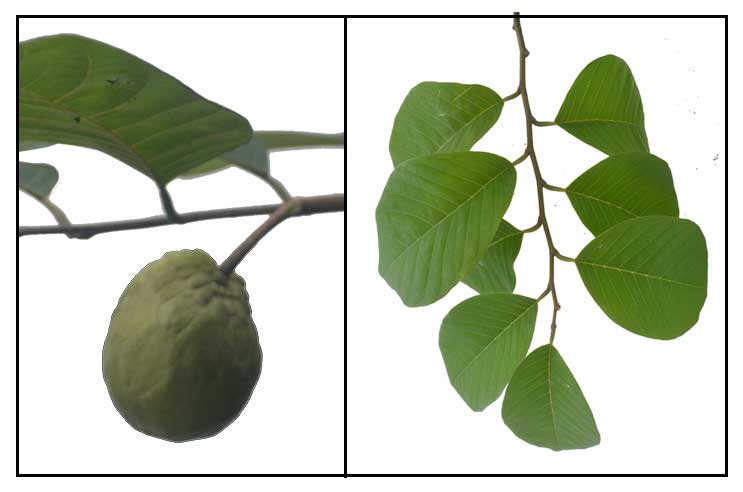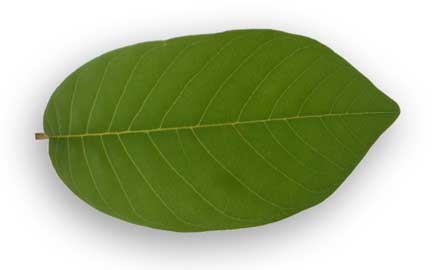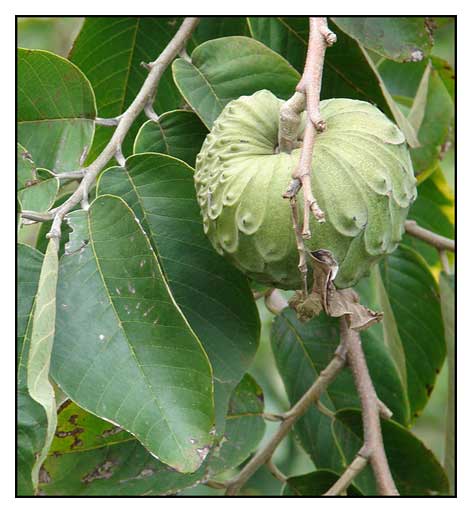 Botany Botany
Cherimoya is a small deciduous tree that grows to a height of 10 meters, low branched, shrubby, spreading 5 to 9 meters. Leaves are alternate, two-ranked, with minute hairy petioles, ovate to elliptic, short and pointed at the apex, slightly hairy at the upper surface, velvety on the lower surface. Flowers are fragrant and solitary, on short, hairy stalks along the branches, with 3 outer, greenish, fleshy, downy petals and 3 smaller, pinkish inner petals. Fruit is cone- or heart-shaped, 10 to 20 centimeters long, up to 10 centimeters wide, containing numerous hard, brown or black glossy seeds, 1 to 2 centimeters long.
 - In Peru, cherimoyas are classified according to degree of surface irregularity: Lisa (almost smooth), impresa (with fingerprint depressions), umbonada (rounded protrusions), papilonado or tetilado (fleshy, nipple-like protrusions), tuberculada (conical protrusions with wartlike tips). (1) - In Peru, cherimoyas are classified according to degree of surface irregularity: Lisa (almost smooth), impresa (with fingerprint depressions), umbonada (rounded protrusions), papilonado or tetilado (fleshy, nipple-like protrusions), tuberculada (conical protrusions with wartlike tips). (1)
Distribution
- Introduced.
- Cultivated for its edible fruit.
- It does well in the Mountain Province at an altitude above 2,460 feet.
- Native to southern Ecuador and northern Peru.
 Constituents Constituents
- Plant yields alkaloids, flavonoids, glycosides, saponins, tannins, carbohydrates, proteins, phenolic compounds, phytosterols, and amino acids. (12)
-
Nutrient analysis per 100 g of fruit (1 cup=160gm) yields: (Principle) energy 75 Kcal, carbohydrates 17.71 g, protein 1.57 g, total fat 0.68 g, cholesterol 0 mg, dietary fiber 3 g; (Vitamins) folates 23 µg, niacin 0.644 mg, pantothenic acid 0.345 mg, pyridoxine 0.257 mg, riboflavin 0.131 mg, thiamin 0.101 mg, vitamin A 5 IU, vitamin C 12.6 mg, vitamin E 0.27 mg; (Electrolytes) sodium 7 mg, potassium 287 mg; (Minerals) calcium 10 mg, copper 0.069 mg, iron 0.27 mg, magnesium 17 mg, manganese 0.093 mg, phosphorus 26 mg, zinc 0.16 mg' (Phytonutrients) carotene-ß 2 µg, cryptoxanthin-ß 1 µg, lutein-zeaxanthin 6 µg. (7)
- Studies on stems and seeds have yielded various chemical constituents including annocherine A and B, cherianoine, aromin-A, N-cis-caffeoyltyramine, dihydro-feruloyltyramine, N-transferuloylmethoxytyramine, and N-cis-feruloyltylmethoxytyramine. (12)
- Bioassay-guided fractionation of ethanol extract of leaves yielded five phenolic compounds: caffeic acid, quercetin, kaempferol, nicotinflorin, and rutin. (see study below) (3)
- Yields numerous bioactive chemicals i.e., annonaceous acetogenins, annocherine A, cherianoine, annocherine B, chermolin, annomolin, romucosine H, anonaine, among others.
- GC-MS analysis of essential oils of fresh leaves, flowers, and fruits obtained by steam distillation yielded 60 constituents.
Main constituents in the oil of leaves were bicyclogermacrene, trans-caryophyllene and δ-amorphene; flowers yield main constituents of bicyclogermacrene, α-terpinolene and germacrene D, and oil of fruits yielded main constituents of β-pinene, α-terpinolene, β-fenchyl alcohol and α-pinene. (see study below) (10)
- GC-MS analysis of bark for essential oil major compounds of methyl butanoate (69.08%), butyl butanoate (56.56%), 3-methylbutyl betanoate (15.36%), 3-methyl-butyl 3-methyl butanoate (56.69%) and 5-hydroxymethyl-2-furfural (71.82%). (12)
- Bioassay-guided fractionation of ethanol extract of leaves yielded five phenolic compounds: caffeic acid, quercetin, kaempferol, nicotinflorin, and rutin. (see study below) (3)
- Study of stems yielded
35 compounds including twenty‐one alkaloids: lysicamine (1), liriodenine (2), atherospermidine (3), oxoxylopine (4), oxoanolobine (5), oxoglaucine (6), (‐)‐anonaine (7), (‐)‐asimilobine (8), (‐)‐xylopine (9), (‐)‐anolobine (10), (‐)‐norisocorydine (11), (+)‐laurotetanine (12), (+)‐isocorydine (13), (‐)‐N‐methylasimilobine (14), (+)‐N‐methyllaurotetanine (15), (‐)‐norushinsunine (16), (‐)‐ushinsunine (17), (‐)‐N‐formylanonaine (18), (+)‐stepharine (19), (+)‐orentaline (20), and (‐)‐kikemanine (21); four kauranes, ent‐kaur‐16‐en‐19‐oic acid (22), 16β‐hydroxy‐17‐acetoxy‐ent‐kauran‐19‐al (23), 17‐acetoxy‐16β‐ent‐kauran‐19‐oic acid (24), and 16β‐hydroxy‐17‐acetoxy‐ent‐kauran‐19‐oic acid (25); two amides, N‐trans‐femloyltyramine (26), and N‐trans‐caffeoyltyramine (27); one purine, adenosine (28); one lactam amide, squamolone (29); and six steroids, β‐sitosterol (30), stigmasterol (31), β‐sitostenone (32), stigmasta‐4,22‐dien‐3‐one (33), 6β‐hydroxy‐β‐sitosterone (34), and 6β‐hydroxystigmasterone (35) . (20)
Properties
-
Studies have suggested antioxidant, hypolipidemic, antidiabetic, antiprotozoal properties.
Toxicity
- Seeds, like all Annona species, are toxic and should be removed from the pulp before blending.
- Blindness can result from the juice of crushed seeds coming in contact with the eyes. (6)
- Seeds and twigs contain several alkaloids including (+)-reticuline, (-)-anonaine, liriodenine, and lanuginosine.
(6)
- Ingestion of 0.15g of seed resin can cause symptoms resembling atropine effects. (6)
- Seeds are an important source of acetogenins, a type of alkaloid with antiparasitic and cytotoxic activities. (7)
Parts used
Seeds, rind.
Uses
Edibility
- Essentially a desert fruit that is eaten fresh.
-
Fruit is juicy, slight sweet, and a little tart, with a delicious flavor cross between a pineapple and banana. Added to fruit salads and various dessert recipes. Pulp may be blended with orange juice and lime juice.
- Used for making ice cream, milkshakes or sorbets. (12)
- Immature fruits used in vegetable curries. (12)
- Caution: seed is toxic. (see toxicity above)
Folkloric
- In Mexican traditional medicine, used for treatment of diarrhea and dysentery.
- Powdered seed mixed with grease as treatment for parasitic skin diseases.
- Seeds are toasted, peeled, and pulverized to a powder, taken with water or milk as potent emetic or cathartic. Decoction of rind taken to treat pneumonia. (6)
- Fruit used for digestive disorders such as stomachache and ulcers. Bark decoction used a tonic and as remedy for diarrhea. Root chewed to relieve toothaches. Root decoction drunk to treat fevers. Leaf decoction used to treat worms. (12)
Others
- Insecticide: Crushed seed used as insecticide. (6) Crushed seeds used to kill lice and cure parasitic skin conditions. (12)
- Snuff flavoring: In Jamaica, dried flowers used as flavoring for snuff. (12)
Studies
• Antiprotozoal / Kaempferol / Leaves: Bioassay-guided fractionation of ethanol extract of leaves yielded five phenolic compounds: caffeic acid, quercetin, kaempferol, nicotinflorin, and rutin. In vitro antiprotozoal assay showed kaempferol was the most potent antiamoebic and antigiardial compound with IC50 values of 7.9 µg/ml for Entamoeba histolytica and 8.7 µg/ml for Giardia lamblia. (3)
• Antioxidant and Hypolipidemic Effects / Leaves: Study evaluated the antioxidant effect of oral administration of methanol extract of Annona cherimola leaf on antioxidant enzymes and lipid peroxidation in blood-Triton WR 1339 induced rat. Results showed improvement of antioxidant enzymes associated with an increase in body weight control and healthier lipid profiles suggesting antiobesity and hypolipidemic effects. (4)
• Alkaloids / Annona cherimola x Annona squamosa / Leaves: Atemoya is an interspecific annonaceous hybrid between A. cherimola Mill. and A. squamosa L. Phytochemical screening yielded seven alkaloids, including two aporphine (annonaine and asimilobine), three oxoaporphine (lanuginosine, liriodenine, and lysicamine) and two proaporphine (pronuciferine and stepharine). The species is an important source of aporphine alkaloids with a high relationship with other Annona species. (8)
• Cytotoxic Cyclic Heptapeptide / Seeds: Methanol extract of seeds yielded a new cyclic heptapeptide, cherimolacyclopeptide C. It exhibited significant in vitro cytotoxic activity against KB cells, with an IC50 value of 0.072 µM. (9)
• Antimicrobial / Essential Oil: GC-MS analysis of essential oils of fresh leaves, flowers, and fruits obtained by steam distillation yielded 60 constituents. Study reported In vitro antimicrobial activity of three essential oils and some of their major constituents against five gram (±) bacteria and one fungus. (see constituents above) (10)
• Antihyperglycemic / Rutin / Leaves: Study evaluated an ethanol extract of A. cherimola, subsequent fractions, and rutin on alloxan-induced type 2 diabetic rats. Bioactive-guided fractionation of EEAc yielded a major antihyperglycemic compound, rutin. EEAc attenuated postprandial hyperglycemia. Results suggest rutin as an a-glucosidase inhibitor was responsible in part for the antihyperglycemic activity of A. cherimola. (11)
• Antioxidant
/ Fruits: Study evaluated the antioxidant activity of pulp, peel, and seeds for four cultivars from A. cherimola from the Madeira Island. The peel showed highest antioxidant activity with EC50 of 0.97 mg/ml. and total flavonoids (44.7 epicatechin equivalents/100g). Lutein was the most abundant carotenoid, ranging from 129 to 232 µg/100g. Peel yielded highest l-ascorbic acid (4.41 mg/100g). (14)
• Antioxidant / Cytoprotective / Fruits: Study evaluated organic solvents of the pulp of ripe fruits for antioxidant, total phenols, and cytoprotective activity. The organic extracts showed potent antioxidant and ferric reducing power activities. A dimethyl formammide extract showed highest scavenging activity using DPPH, ABTS, O2-radical and FRAP assays, while an ethanol extract showed highest activity against lipid peroxidation. All extracts significantly enhanced cell survival of isolated human peripheral blood lymphocytes. Results showed strong antioxidant properties, remarkable decrease of lipid peroxidation, and cytoprotective effects against strong oxidant. (15)
• Radical Scavenging / Modulatory Effect on Complications in Alloxan-Induced Diabetic Rats: Study evaluated the modulatory effect of A. cherimola against complications and oxidative stress in alloxan-induced diabetic rats. In vitro a-inhibition assay showed 26-57% inhibition. A. cherimola extract showed significant activity by regulating release of insulin (46-159%), C-peptide (61-72%), maintaining levels of GHb (1-28%) and atherogenic index. Liver, renal, and chemical markers reverted back to near normal. Enzymatic antioxidant (SOD and CAT) levels showed improvement in radical scavenging potential. (16)
• Antihyperglycemic / Rutin / Leaves: Cherimoya has been reported in Mexican traditional medicine for the treatment of diabetes. Study evaluated ethanol extract, fractions, and rutin from Annona cherimola in alloxan-induced type 2 diabetic rats. Bioassay-guided fractionation yielded a major antihyperglycemic compound, rutin. Rutin attenuated postprandial hyperglycemia in an acute assay. In a subchronic assay, the ethanol extract and rutin showed blood glucose reduction comparable to acarbose. Results suggest rutin as a-glucosidase inhibitor was responsible in part for the antihyperglycemic acidity of A. cherimola. (17)
• Antinociceptive / Anti-Inflammatory / Atemoya: Atemoya is an interspecific hybrid between Annona cherimola Mill. and Annona squamosa L. Study of an ethanol extract of atemoya showed relief of pain and inflammation in experimental models in rats. Acetic acid induced writhing, formalin and hot plate tests were used for antinociceptive evaluation and carrageenan-induced peritonitis for anti-inflammatory testing. (18)
• Antihyperlipidemic: Study evaluated a methanolic extract of Annona cherimola for antihyperlipidemic potential in a model of acute hyperlipidemia induced by a single administration of Triton WR 1339 intra-peritoneally in rats. Results showed significant dose dependent decrease in plasma cholesterol, triglycerides, and LDL cholesterol along with a considerable increase in HDL cholesterol. Fenofibrate was used as reference standard. (19)
Availability
- Cultivated.
- Seeds in the cybermarket.
|

![]()



 Botany
Botany - In
- In 
